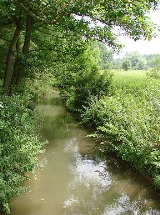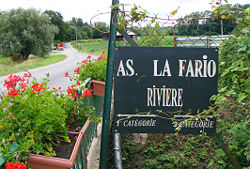
Ardre
Encyclopedia
The Ardre is a fifth order river in France which flows into the Vesle
(left tributary) thence into the Aisne
, Oise
and Seine
.
and flows on bearing of about 310° from the Parc Régional de la Montagne de Reims to enter the Vesle
at Fismes
.
It rises at an altitude of about 270 metres and descends over a course of 39 kilometres, to about 80m in Fismes. It is crossed by the Paris
to Reims motorway, A4/E50 about half way along the river's length.
It's geology is comparable with that of the lower Thames valley and south Hampshire. Though the chalk of the Champagne plateau is not far away, towards Reims, the immediate surroundings are of middle Eocene but the river has cut down into lower Eocene clay deposits like those at Chichester
. Consequently, the landscape is much more wooded than that typical of Champagne
.
, in the département of Marne situated at its confluence with the Vesle
. The catchment area of the river is 297 km² (114.7 sq mi).
The mean of the annual flow rates or module
, at Fismes over this period was shown to be 1,56 m³ per second.
The seasonal fluctuations are small, at least, when compared with the typical French water course. The higher flows occur in the winter to spring period, taking the monthly flow rates to between 1,95 and 2,54 m³ per second, from December to April with a slight peak in February. The low flows occur during in late summer and early autumn, from July to October. This gives a low in the mean monthly flow rate of 0,68-0,70 m³ in August and September.
Mean monthly flow (m³/s) measured at the hydrological station at Fismes - data calculated over 37 years

 At the point of lowest mean flow, in the case of a drought to be expected statistically once in five years, which is not serious, the VCN3 .
At the point of lowest mean flow, in the case of a drought to be expected statistically once in five years, which is not serious, the VCN3 .
Unlike the Vesle, in the Ardre peaks in flow can be quite great. This arises from the small mean flow and the small catchment area. The QIX 10 is 17 m³ per second, the QIX 20, 21 m³, while the QIX 50 is 25 m³ per second. (The mean monthly flow in the wettest month of the year is 2,54 m³ per second.)
The greatest momentary flow recorded at Fismes during the period of evaluation was 28,6 m³ per second on the 26 March 1988, while the maximum daily flow was 22,5 m³ per second, on the same day. Comparing the former value with the QUIX scale for the river, this flow was greater than the 60 year maximum calculated from the QUIX 50, therefore exceptional.
, in other words, it is fished primarily for salmonids such as brown trout
(Salmo trutta fario). Below the bridge, it becomes a second category river, offering principally cyprianids (white fish).
and 62nd Divisions, with attached New Zealanders, fought in cooperation with French V Army forces on each flank and with Italian artillery support, in July 1918, during the Second Battle of the Aisne
.
Vesle
The Vesle is the river on which the city of Reims stands. It is a fourth order river of France and a left-bank tributary of the Aisne River. It is 140 kilometres long, rises in the département of Marne through which it flows most of its course.-Geography:...
(left tributary) thence into the Aisne
Aisne
Aisne is a department in the northern part of France named after the Aisne River.- History :Aisne is one of the original 83 departments created during the French Revolution on 4 March 1790. It was created from parts of the former provinces of Île-de-France, Picardie, and Champagne.Most of the old...
, Oise
Oise
Oise is a department in the north of France. It is named after the river Oise.-History:Oise is one of the original 83 departments created during the French Revolution on March 4, 1790...
and Seine
Seine
The Seine is a -long river and an important commercial waterway within the Paris Basin in the north of France. It rises at Saint-Seine near Dijon in northeastern France in the Langres plateau, flowing through Paris and into the English Channel at Le Havre . It is navigable by ocean-going vessels...
.
Geography
The river lies to the west of ReimsReims
Reims , a city in the Champagne-Ardenne region of France, lies east-northeast of Paris. Founded by the Gauls, it became a major city during the period of the Roman Empire....
and flows on bearing of about 310° from the Parc Régional de la Montagne de Reims to enter the Vesle
Vesle
The Vesle is the river on which the city of Reims stands. It is a fourth order river of France and a left-bank tributary of the Aisne River. It is 140 kilometres long, rises in the département of Marne through which it flows most of its course.-Geography:...
at Fismes
Fismes
Fismes is a commune in the Marne department in north-eastern France.- Economy :Many agricultural zones of the region may soon become a section of the zone for production of Champagne.- Antiquity :...
.
It rises at an altitude of about 270 metres and descends over a course of 39 kilometres, to about 80m in Fismes. It is crossed by the Paris
Paris
Paris is the capital and largest city in France, situated on the river Seine, in northern France, at the heart of the Île-de-France region...
to Reims motorway, A4/E50 about half way along the river's length.
It's geology is comparable with that of the lower Thames valley and south Hampshire. Though the chalk of the Champagne plateau is not far away, towards Reims, the immediate surroundings are of middle Eocene but the river has cut down into lower Eocene clay deposits like those at Chichester
Chichester
Chichester is a cathedral city in West Sussex, within the historic County of Sussex, South-East England. It has a long history as a settlement; its Roman past and its subsequent importance in Anglo-Saxon times are only its beginnings...
. Consequently, the landscape is much more wooded than that typical of Champagne
Champagne (province)
The Champagne wine region is a historic province within the Champagne administrative province in the northeast of France. The area is best known for the production of the sparkling white wine that bears the region's name...
.
Hydrology
The Ardre's flow was observed during a period of 37 years (1969–2005), at FismesFismes
Fismes is a commune in the Marne department in north-eastern France.- Economy :Many agricultural zones of the region may soon become a section of the zone for production of Champagne.- Antiquity :...
, in the département of Marne situated at its confluence with the Vesle
Vesle
The Vesle is the river on which the city of Reims stands. It is a fourth order river of France and a left-bank tributary of the Aisne River. It is 140 kilometres long, rises in the département of Marne through which it flows most of its course.-Geography:...
. The catchment area of the river is 297 km² (114.7 sq mi).
The mean of the annual flow rates or module
Module
Module or modular may refer to the concept of modularity. It may also refer to:-Computing and engineering:* Modular design, the engineering discipline of designing complex devices using separately designed sub-components...
, at Fismes over this period was shown to be 1,56 m³ per second.
The seasonal fluctuations are small, at least, when compared with the typical French water course. The higher flows occur in the winter to spring period, taking the monthly flow rates to between 1,95 and 2,54 m³ per second, from December to April with a slight peak in February. The low flows occur during in late summer and early autumn, from July to October. This gives a low in the mean monthly flow rate of 0,68-0,70 m³ in August and September.
Mean monthly flow (m³/s) measured at the hydrological station at Fismes - data calculated over 37 years


Unlike the Vesle, in the Ardre peaks in flow can be quite great. This arises from the small mean flow and the small catchment area. The QIX 10 is 17 m³ per second, the QIX 20, 21 m³, while the QIX 50 is 25 m³ per second. (The mean monthly flow in the wettest month of the year is 2,54 m³ per second.)
The greatest momentary flow recorded at Fismes during the period of evaluation was 28,6 m³ per second on the 26 March 1988, while the maximum daily flow was 22,5 m³ per second, on the same day. Comparing the former value with the QUIX scale for the river, this flow was greater than the 60 year maximum calculated from the QUIX 50, therefore exceptional.
Fisheries
The Ardre is a water of the first category down to the bridge at Faverolles-et-CoëmyFaverolles-et-Coëmy
Faverolles-et-Coëmy is a commune in the Marne department in north-eastern France.-See also:*Communes of the Marne department...
, in other words, it is fished primarily for salmonids such as brown trout
Brown trout
The brown trout and the sea trout are fish of the same species....
(Salmo trutta fario). Below the bridge, it becomes a second category river, offering principally cyprianids (white fish).
History
The Ardre became a footnote in British military history as the river down the valley of which the British 51stBritish 51st (Highland) Division (World War I)
The 51st Division was a British Territorial Force division that fought on the Western Front in France during the First World War. The division's insignia was a stylised 'HD' inside a red circle. Early doubts about the division's performance earned it the nickname of "Harper's Duds" after the...
and 62nd Divisions, with attached New Zealanders, fought in cooperation with French V Army forces on each flank and with Italian artillery support, in July 1918, during the Second Battle of the Aisne
Second Battle of the Aisne
The Second Battle of the Aisne , was the massive main assault of the French military's Nivelle Offensive or Chemin des Dames Offensive in 1917 during World War I....
.

